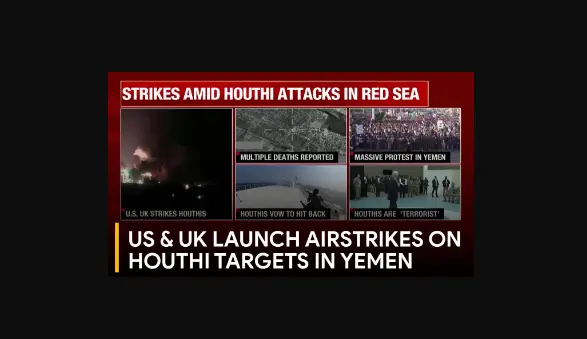US Launched Strikes on Houthi Targets in Yemen.
US Doubles Down on Yemeni Strikes: Red Sea Security Takes Center Stage
The United States, determined to secure vital Red Sea shipping lanes, launched a second round of airstrikes against Houthi targets in Yemen, pushing tensions in the region to new heights.
Read More: Global Oil Prices Increased by 3% After Houthi Attacks
Key Points:
- Target Acquired: This “follow-on action” specifically aimed at a Houthi radar site, following the initial joint UK-US strikes on dozens of Houthi positions.
- International Effort: Australia and Canada joined the US and UK in backing the operation, highlighting collective concern about Houthi attacks on crucial maritime routes.
- Defending Commerce: The US Central Command emphasized the strikes aim to disrupt Houthi capabilities and safeguard seaborne trade in the Red Sea, which carries a significant portion of global oil, gas, and grain.
- Houthi Retaliation: Despite claims of minimal impact, Houthi officials vowed a “strong and effective response,” raising concerns about further escalation.
- Beyond Borders: Protests erupted in Yemen’s capital, expressing solidarity with Palestinians and opposing the US intervention, though officials in both the US and the UK insist their actions are solely focused on maritime security.
Implications:
- The continued air strikes and heightened tensions raise fears of broader regional instability, potentially drawing other Middle Eastern players into the conflict.
- The focus on Red Sea security underscores its global economic importance, as vital trade depends on maintaining stability in the region.
- While both sides maintain distinct objectives, the convergence of the Yemen conflict with the Israel-Gaza conflict in the minds of some regional actors could complicate efforts to de-escalate the situation.
The UK and the US assert their actions aim to protect vital shipping routes, unrelated to the Israel-Gaza conflict.
The Red Sea handles 15% of global seaborne trade, including 8% of global grain, 12% of seaborne oil, and 8% of the world’s liquefied natural gas, as per the White House.
Note: The information above might not be accepted 100%. Please verify from your own sources. We will not be responsible for any kind of loss due to our content.
For more news, please visit Munafa Marketing.




